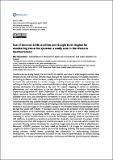Por favor, use este identificador para citar o enlazar a este item:
http://hdl.handle.net/10261/268198COMPARTIR / EXPORTAR:
 SHARE
BASE SHARE
BASE
|
|
| Visualizar otros formatos: MARC | Dublin Core | RDF | ORE | MODS | METS | DIDL | DATACITE | |

| Título: | Use of Sentinel-2A/B satellites and Google Earth Engine for monitoring estuarine systems: a study case in the Western Mediterranean |
Autor: | Roca Mora, Mar; Navarro, Gabriel CSIC ORCID ; García Sanabria, Javier; Caballero, Isabel CSIC ORCID | Fecha de publicación: | 19-abr-2021 | Editor: | Copernicus Publications | Citación: | EGU General Assembly (2021) | Resumen: | Coastal areas are being rapidly transformed in the last 50 years due to anthropogenic causes. New infrastructures and intensive activities have changed the natural behaviour of coastal ecosystems, promoting problems related to water quality, eutrophication and coastal erosion. This situation increases the vulnerability to climate change, requiring important efforts in monitoring and defining protocols for optimizing operational decision-making and strategic management. Remote sensing techniques are becoming a key tool for coastal mapping in terms of resolution, effectiveness and cost reduction. In the last decade, the European Commission launched the Copernicus programme for Earth Observation as a way of improving coastal monitoring with higher resolution. Sentinel-2A/B twin satellites are part of this free and open policy programme available since 2015, but atmospheric corrections or cloud cover are still challenges to face. In order to process this data, cloud computing platforms such as Google Earth Engine (GEE) have revolutionized the way satellite images are processed, without the need to download and store local data. The present study aimed at developing a GEE-based technique for selecting cloud-free Sentinel-2 Level-2A images in the Guadiaro estuary in the Western Mediterranean (Spain) during the last four years (2017-2020). It has been used to analyse the evolution of the sand bar and to identify hotspots in its sedimentary variation along the coast, at 10 m and 5 days spatial and temporal resolution respectively. NDWI index was evaluated using 0.05 to 0.15 threshold, revealing 0.1 as the best threshold to be used for land/water mapping, easily incorporated in the GEE platform. In addition to Sentinel-2 potential, this study also demonstrates the power of GEE, computing more than 400 images for statistical analysis in terms of seconds, which enabled the automatic filtering method developed for cloud-free images selection with a 95% of effectiveness. Moreover, ACOLITE processor has been used on Sentinel-2 L1A images for atmospheric and sunglint correction to generate Level-2 data and for analysing turbidity and water quality patterns during extreme rainfall events, providing key information as early-warning indicators development. This improvement will be useful for near future implementation of remote sensing applications for coastal managers, ensuring a continuous and detailed monitoring and helping to support an ecosystem-based approach for coastal areas. | Descripción: | Trabajo presentado en EGU General Assembly, celebrada en modalidad virtual del 19 al 30 de abril de 2021. | Versión del editor: | http://dx.doi.org/10.5194/egusphere-egu21-15400 | URI: | http://hdl.handle.net/10261/268198 | DOI: | 10.5194/egusphere-egu21-15400 | Identificadores: | doi: 10.5194/egusphere-egu21-15400 |
| Aparece en las colecciones: | (ICMAN) Comunicaciones congresos |
Ficheros en este ítem:
| Fichero | Descripción | Tamaño | Formato | |
|---|---|---|---|---|
| EGU21-15400-print.pdf | 277,61 kB | Adobe PDF |  Visualizar/Abrir |
CORE Recommender
Page view(s)
31
checked on 15-may-2024
Download(s)
281
checked on 15-may-2024
Google ScholarTM
Check
Altmetric
Altmetric
Este item está licenciado bajo una Licencia Creative Commons

